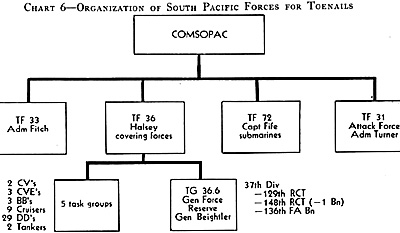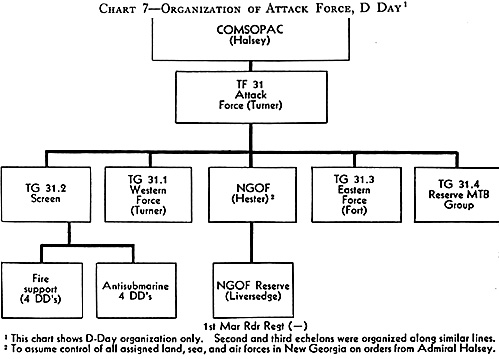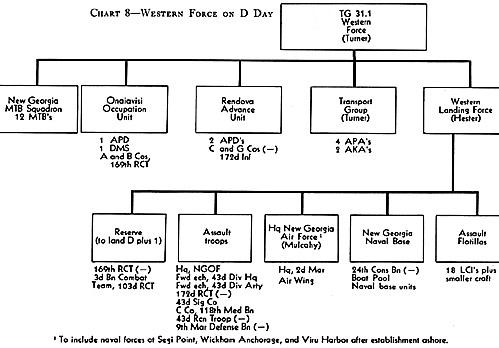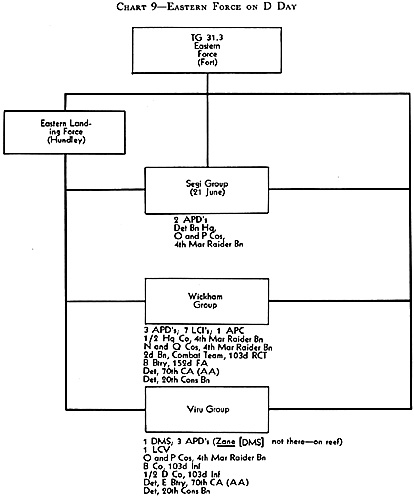 Final plans and orders for TOENAILS were
ready in June. (Two files previously cited, USAFISPA
G-2 Hist See File, Plug for New Georgia Opn, and
USAFlSPA File NO. 381, Preliminary Plng
COMSOPAC and CONIGENSOPAC, contain valuable
material for the student interested in the genesis and
development of tactical plans. This subsection is based
on these two files and on Hq NGOF FO 1, 16 Jun 43, and
Addendum 1, 24 Jun 43; 43d Div FO 1, 17 Jun 43;
COMSOPAC Opn Plan 14-43, 3 Jun 43, with annexes;
CTF 31 Opn Plan A8-43, 4 Jun 43, with annexes; CTG
31-3 Opn Order AL 10-43, 21 Jun 43; CTG 31-1 Loading
Order 1-43, 13 Jun 43; CTG 31.3 Loading Order 1-43,
16 Jun 43. Last five in Off of Naval Rcds and Library.)
Final plans and orders for TOENAILS were
ready in June. (Two files previously cited, USAFISPA
G-2 Hist See File, Plug for New Georgia Opn, and
USAFlSPA File NO. 381, Preliminary Plng
COMSOPAC and CONIGENSOPAC, contain valuable
material for the student interested in the genesis and
development of tactical plans. This subsection is based
on these two files and on Hq NGOF FO 1, 16 Jun 43, and
Addendum 1, 24 Jun 43; 43d Div FO 1, 17 Jun 43;
COMSOPAC Opn Plan 14-43, 3 Jun 43, with annexes;
CTF 31 Opn Plan A8-43, 4 Jun 43, with annexes; CTG
31-3 Opn Order AL 10-43, 21 Jun 43; CTG 31-1 Loading
Order 1-43, 13 Jun 43; CTG 31.3 Loading Order 1-43,
16 Jun 43. Last five in Off of Naval Rcds and Library.)
Halsey had hoped to invade New Georgia in April, but could not move before the Southwest Pacific was ready to move into the Trobriands and Nassau Bay. The general concept of the operation was worked out by Admiral Halsey, a planning committee, and members of Halsey's staff. The committee consisted of General Harmon, the Army commander; Admiral Fitch, the land-based air commander; Admiral Turner, the amphibious commander; and General Vogel of the I Marine Amphibious Corps. The principal staff officers concerned were Admiral Wilkinson; Captain Browning, Halsey's chief of staff; nd General Peck, Halsey's war plans officer. By May agreement was reached on the general plan. It called for the simultaneous seizure of Rendova, Viru Harbor, Wickham Anchorage, and Segi Point. A fighter field would be built at Segi Point.
After the initial landings small craft from Guadalcanal and the Russells would stage through Wickham Anchorage and Viru Harbor to build up Rendova's garrison. Munda's field would be harassed and neutralized by 155-mm. guns and 105-mm. howitzers emplaced on Rendova and the nearer barrier islands. These moves were preparatory to the full-scale assaults against Munda and Vila, and later against southern Bougainville.
Assigned to the operation were South Pacific aircraft, warships, the South Pacific Amphibious Force, and the heavily reinforced 43d Division with its commander, Maj. Gen. John H. Hester, in command of the landing forces. The 37th Division, less elements, was in area reserve to be committed only on Halsey's orders.
Final plans and tactical organization were complicated, as TOENAILS called for four separate simultaneous invasions (Rendova, Wickham Anchorage, Segi Point, and Viru Harbor) with the Rendova landing to be followed by two more on the same island.
Admiral Halsey's basic plan, issued on 3 June, organized the task forces, prescribed their general missions, and directed Admiral Turner to co-ordinate the planning of the participating forces. Four task forces were assigned to the operation: Task Force 33, the Aircraft, South Pacific, under Admiral Fitch; Task Force 72, a group of Seventh Fleet submarines commanded by Capt. James F. Fife and now under Halsey's operational control; Task Force 36, the naval covering force commanded, in effect, by Halsey himself; and Task Force 31, the attack force. (Chart 6)
Task Force 33, to which Halsey temporarily assigned planes from Carrier Division 22 (three escort carriers), was to provide defensive reconnaissance for New Georgia operations and the Southwest Pacific's seizure of Woodlark and Kiriwina, and to cover the area northeast of the Solomons (Southwest Pacific planes were responsible for the Bismarcks). It was to destroy enemy units which threatened South and Southwest Pacific forces, especially Japanese planes operating from New Georgia and southern Bougainville. Fitch's planes were also to provide fighter cover, direct air support, and liaison and spotting planes for the attack force.
Starting D minus 5, Task Force 33 would attempt to isolate the battlefield by attacking the Japanese air bases at Munda, Ballale, Kahili, Kieta, and Vila, and by striking at surface vessels in the Bougainville and Munda areas. During daylight, fighters would cover ships and ground troops, and antisubmarine patrols would be maintained for convoys. Black Cats (PBY's) would cover all night movements. Striking forces at all times were to be prepared to hit enemy surface ships. Beginning on D Day, eighteen dive bombers would remain on stand- by alert in the Russells. Medium bombers were to be prepared to support the ground troops. Finally, arrangements were made for air dropping supplies and equipment to the ground troops in New Georgia.
One innovation in the command of supporting planes had apparently arisen from Mal. Gen. Alexander A. Vandegrift's recommendations based on his experiences in invading Guadalcanal. (See Jeter A. Isely and Philip A. Crowl, The U.S. Marines and Amphibious War: Its Theory, and Its Practice in the Pacific (Princeton, N.J.: Princeton University Press, 1951), P. 172, and Miller, Guadalcanal: The First Offensive, P. 71.)
Halsey directed that on take-off from Guadalcanal and Russells fields planes assigned to missions in the immediate area of operations would come under control of the local air commander (the Commander, New Georgia Air Force).
Direction of fighters over Task Force 31 was to be conducted by a group aboard a destroyer until direction could be conducted ashore on Rendova. Similarly, bomber direction for direct air support would be handled aboard Turner's flagship McCawley until bomber director groups could establish themselves ashore. In early June, Fitch issued orders concentrating most of his strength in the Guadalcanal area under Admiral Mitscher. (Ltr, COMAIRSOPAC to COMSOPAC, 4 Jun 43, sub: Availability of Aircraft at MAINYARD [Guadalcanal] for TOENAILS Opn, in USAFISPA G-2 Hist Sec File, Ping for New Georgia Opn, OCMH.)
Totals for aircraft involved were fairly impressive. On 30 June Fitch had on hand for the operation 533 planes, of which 213 fighters, 170 light bombers, and 72 heavy bombers were ready to fly. (ONI USN, Operations in the New Georgia Area, p. 62.)
Task Force 36 included part of the 37th Division on Guadalcanal in area reserve, besides all Halsey's naval strength except that assigned to the attack force. Naval units, including aircraft carriers (two CV's and three CVE's), battleships, cruisers, and destroyers, would operate out of Noum6a, New Caledonia, and the New Hebrides into the Coral and Solomon Seas to intercept and destroy any Japanese forces which ventured out. The reserve 37th Division forces were to be committed, on five days' notice, on orders from Halsey.
Captain Fife's submarines would at first conduct offensive reconnaissance from about latitude one degree north southward to the prevailing equatorial weather front. Once the Japanese were aware of the invasions, Fife's boats were either to concentrate on locating enemy vessels or to withdraw south to cover Bougainville Strait and the waters between New Ireland and Buka. This reconnaissance would be in addition to patrols by Central Pacific submarines, which would keep watch over any Japanese surface forces approaching the South from the Central Pacific.
Admiral Turner's attack force (Task Force 3 1) consisted of ships and landing craft from the South Pacific or III Amphibious Force (Task Force 32), Plus the ground troops. These troops, designated the New Georgia Occupation Force, initially included the following units:
- 43d Division
- 9th Marine Defense Battalion
1st Marine Raider Regiment (less two battalions)
136th Field Artillery Battalion (155mm. howitzers), 37th Division
Elements of the 70th Coast Artillery Battalion (Antiaircraft)
One and one-half naval construction battalions
Radar units
Naval base detachments
A boat pool
Elements of the 1st Commando, Fiji Guerrillas (This unit included besides the Fijians some Tongans and a few Solomon Islanders. See [British] Central Office of Information, Among Those Present, PP. 53-56. American documents list this unit variously as "1st South Seas Scout Company ... .. South Pacific Scouts ... .. native troops," and erroneously, as "1st Company, 1st Fiji Infantry," which was a different unit serving at Port Purvis on Florida.)
Creating the New Georgia Occupation Force, and attaching all ground troops to it (instead of attaching the supporting units to the 43d Division), made another headquarters necessary, and threw a heavy burden on 43d Division headquarters. General Hester commanded both force and division, and the 43d Division staff was, in effect, split into two staffs. The 43d Division's staff section chiefs (the Assistant Chiefs of Staff, G-i, G-2, G-3, and G-4), as well as officers from Harmon's headquarters, served on the Occupation Force staff sections, and their assistants directed the division's staff sections. Brig. Gen. Harold R. Barker, 43d Division artillery commander, commanded all Occupation Force artillery-field, seacoast, and antiaircraft.
From the start General Harmon wasdubious about the effectiveness of this arrangement. He was "somewhat concerned that Hester did not have enough command and staff to properly conduct his operation in its augmented concept." (Ltr, Harmon to Handy, 15 Jul 43, quoted in part in Hq SOPACBACOM File, Suppl New Georgia Material, OCMH.)
On 10 June, with Halsey's concurrence, he therefore told Maj. Gen. Oscar W. Griswold, commanding the XIV Corps and the Guadalcanal Island Base, to keep himself informed regarding Hester's plans in order to be prepared to take over if need be. (Rad, COMGENSOPAC to COMGEN MAINYARD, io Jun 43, Hq SOPACBACOM File, SuppI New Georgia Material, OCMH.)
The general plan, of maneuver called for assault troops from Guadalcanal and the Russells to move to Rendova, Segi Point, Wickham Anchorage, and Viru Harbor on APD's, transports, cargo ships, minesweepers, and minelayers. Segi, Wickham, and V1ru would be taken by small forces to secure the line of communications to Rendova while the main body of ground forces captured Rendova. Artillery on Rendova and the barrier islands was to bombard Munda, an activity in which ships' gunfire would also be employed. On several days following D Day, slow vessels such as LST's and LCT's would bring in more troops and supplies. They would travel at night and in daylight hours hide away, protected from Japanese planes by shore-based antiaircraft, in Wickham Anchorage and Viru Harbor. About D Plus 4, when enough men and supplies would be on hand, landing craft were to ferry assault troops from Rendova across Roviana Lagoon to New Georgia to begin the march against Munda. Coupled with this advance would be the amphibious seizure of Enogai Inlet in the Kula Gulf to cut the Japanese reinforcement, supply, and evacuation trail between Munda and Enogai, and thus prevent the Japanese on Kolombangara from strengthening their compatriots on New Georgia. Once Munda and Enogai were secured, it was planned, Vila on Kolombangara would be seized and further advances up the Solomons chain would follow.
Turner organized his force into five groups. (Chart 7)

1. This chart shows D-Day organization only. Second and third echelons were organized along similar lines.
2. To assume control of all assigned land, sea, and air forces in New Georgia on orders from Admiral Halsey.
The Western Force (Task Group 31-1), which Turner commanded in person, would seize Rendova and make subsequent assaults against Munda, Enogai, and Kolombangara. The Eastern Force, under Rear Adm. George H. Fort, was to take Segi, Viru, and Wickham. Task Group 31.2, consisting of eight destroyers, would cover the transports. No ships' gunfire support was planned in advance, but all ships, including transports, were ordered to be ready to deliver supporting and counterbattery fire if necessary.
The New Georgia Occupation Force, under General Hester, included the Western Landing Force (under Hester), which during the amphibious phase would function as part of Turner's Western Force; the Eastern Landing Force (under Col. Daniel H. Hundley), which during the amphibious phase would be part of Fort's Eastern Force; naval base forces for all points to be captured; the reserve under Col. Harry B. Liversedge, USMC; and two more whose designations are not self-explanatory--the New Georgia Air Force and the Assault Flotillas. (Charts 8 and 9)

The New Georgia Air Force, led by Brig. Gen. Francis P. Mulcahy, USMC, consisted initially of Headquarters, 2d Marine Air Wing. In contrast with the system in the Southwest Pacific, this air headquarters was under the landing force commander. Mulcahy was to take over control of New Georgia air operations during the amphibious phase once that control was relinquished by Turner; he would take command of the planes from Guadalcanal and the Russells that would be supporting the attack, once they were airborne. He was eventually to command the air squadrons to be based at Munda and Segi Point. The Assault Flotillas consisted of landing craft to be used to ferry the assault troops from Rendova to New Georgia proper when the attack against Munda was ready to begin.
Two ground force units which Turner retained temporarily under his direct control were small forces designated to make covering landings. The Onaiavisi Occupation Unit, composed of A and B Companies, 169th Infantry, was to land from two APD's and one minesweeper on Sasavele and Baraulu Islands on either side of Onaiavisi Entrance to hold it until the day of the assault against the mainland through the entrance.

The landing of the occupation unit was scheduled for 0330, 30 June. The Rendova Advance Unit, C and G Companies (each less one rifle platoon), was to land from two APD's on Rendova at 0540 to cover the landing of the main body of the Western Landing Force. The latter, about 6,300 strong, was to start landing on Rendova at 0640, 30 June.
Command over all air sea, and ground forces in New Georgia would pass from Turner to Hester on orders from Halsey.
The presence of the DRYGOODS Stockpiles on Guadalcanal greatly simplified logistical problems. Three Army units of fire and thirty days' supplies were to be put ashore at Rendova, and five units of fire and thirty days' supplies at Viru, Segi, and Wickham. Supply levels were to be built to a sixty-day level out of the DRYGOODS stocks. General Griswold was told to make the necessary quantities available to Turner. Turner was responsible for the actual movement of supplies to New Georgia.
Directions for unloading during the assault phase were simple and clear. Turner instructed all vessels to be ready for quick unloading. All ships were to square away before reaching the transport areas offshore, and if possible to work all hatches from both sides. Unloading parties included 150 men for each cargo ship and transport, 150 men per LST, 50 men per LCT, and 25 men per LCI. The shore party totaled 300 men. Once ashore, cargo was to be moved off the beaches and into inland dumps as fast as possible.
Secondary Landings
With tactical plans for TOENAILS largely ready by mid-June, the invasion forces spent the rest of the month making final preparations-checking weapons and supplies, conducting rehearsals in the New Hebrides, and studying orders, maps, and photographs. South Pacific aircraft pounded Vila, Munda, and the Shortlands-Bougainville bases while Southwest Pacific planes continued their long-range strikes against Rabaul.
More Toenails: The Landings in New Georgia
- South Pacific Organization
Preparation
Tactical Plans
Segi Point, Wickham Anchorage, and Viru Harbor
Battle Over Rendova
Move to Zanama and Rice Anchorage
Large Map of New Georgia Landings (slow: 135K)
Jumbo Map of New Georgia Landings (monstrously slow: 792K)
Back to Table of Contents -- Operation Cartwheel
Back to World War Two: US Army List of Issues
Back to MagWeb Magazine List
© Copyright 2002 by Coalition Web, Inc.
This article appears in MagWeb (Magazine Web) on the Internet World Wide Web.
Other military history articles and gaming articles are available at http://www.magweb.com